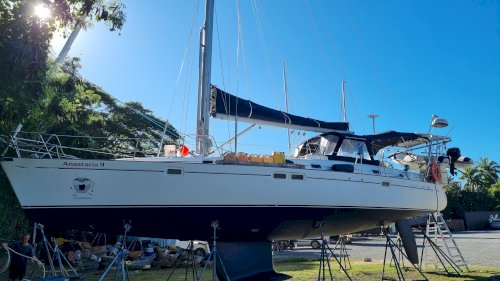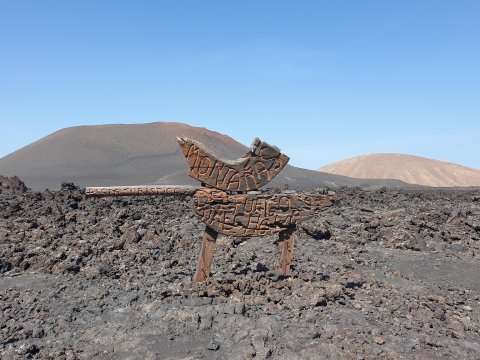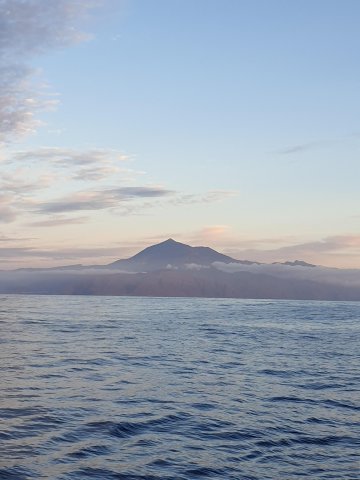
After the visit to Porto Santo, we sailed to the larger island of Madeira. We got a place at the marina on the south-eastern part of the island, Quinta do Lorde, and arrived at about the same time as our Swedish boat neighbors on Aurora. This is the island of flowers! If you come here in the spring, it will be a spectacular scene of colors from all the flowering trees and plants. Now, at the beginning of October, it is not as colorful but still much greener than on the neighboring island of Porto Santo. It felt a little provocative to see that the hibiscus plants were still blooming and being used as hedge plants here. We who, at home in Sweden, struggled to keep them alive, as potted plants indoors... Maybe that says as much about our cultivation ability as the climate differences...
Madeira stretches over 1800 m above sea level, which contributes to more precipitation as the clouds are pushed upwards and leave behind moisture and rain. Although the water is unevenly distributed over the island, it is relatively fertile. Just as in Porto Santo, early on, inhabitants have tried to take advantage of the water and lead it on through so-called levadas, small water channels that lead water down to the cultivation areas. To access these, the surface of the mountain slopes has been redistributed so that it looks like small terraces. These have been reinforced in several places and are now used as popular hiking trails. Large parts of Madeira are covered by these trails, which are fairly well maintained, but even so, there are sometimes fatal accidents when tourists fall down the cliff edges!
We could not rent a motorcycle on the island, it was not recommended, said the helpful girls at the marina. Instead, we rented a car to look around the island. During a whole day we drove around to different places. We visited both the northern and southern parts and tried to avoid all the tunnels in order to see as much as possible of the places we traveled through. It probably contributed to the fact that it took an extra-long time as we had to drive on small winding roads around high, steep mountain ranges. In many places, the mountain sides consisted mostly of petrified ash, which makes them extra porous. Gravel and stone are constantly loosened and stones roll onto the roads. Here, too, we could see fantastic formations, formed when lava flows forced their way up through older layers of volcanic ash. We sat like two wide-eyed owls and looked out the car window and marveled!
In the middle of the island there is a now well-protected primeval forest "The Laurisilva of Madeira". It is a subtropical rainforest that is a preserved remnant from over 15-40 million years ago when this type of forest covered large parts of southern Europe. In the Laurisilva forest there is a great diversity of species and several endemic species that therefore only live here. The forest is on the UNESCO World Heritage List. It is said that there are trees here that are over 800 years old and that therefore lived before the Portuguese came to the island! We passed by the forest and both got a nice feeling from all the green that surrounded us. We probably missed Sweden's forests, we realized afterwards...
Madeira, like Porto Santo, has been used as a base for further voyages of discovery to the west. Wheat was first grown here and then, for a period, sugar beet. Slaves were used as labor on these plantations. Now we could see how the banana plantations had taken over and we learned that the organic cultivation methods are becoming more and more widespread. They are also trying to find better alternatives to the plastic bags with which they cover the banana logs to create an optimal microclimate.
One day we decided to try a hiking trail. We walked along the mountain ridge that stretches towards the southeastern tip of the island and plunges down to the sea. We were far from alone and as time went on, more visitors appeared on the trails in the heat. During our hike, we marveled at the various colorful petrified layers of ash and various streaks of dark basalt that ran across the ash layers. In addition, we could see how large stones were embedded in the volcanic ash and protruded like small bombs from the cliff walls. We had no idea how all this came about and really missed someone who could explain it to us. When we had walked for a while, we were joined by a Canadian lady who curiously asked if we were geologists? Surprised, we replied that we were just interested tourists. She laughed and said that her husband, who was a geologist himself, saw us and swore that we were experts because we were standing and pointing and discussing exactly the places, he himself thought were interesting. Of course, we were completely unaware of what we were looking at, but now we saw our chance! We started a conversation with the couple and it soon turned out that their son played in an ice hockey team in Hofors, Sweden! Eventually, when we felt we had familiarized ourselves enough, we took the opportunity to ask the man if he would be willing to tell us anything about the volcanic remains, we had seen in the area. Oh, the wife warned us. You will be given a lecture!…
A bit later we knew much more about the island's geology! 😉
As the forecast showed favorable winds, we quickly decided to set off again, although we would have liked to have stayed a little longer in Madeira. The Spanish courtesy flag was once more raised and after 1.5 days we were in Lanzarote, Canary Islands. Now we stay anchored on the south side of the island and are planning for the coming weeks. At the end of October/beginning of November, we take a short break (also in blog posting), leave the boat on one of the islands here and travel to Sweden to, among other things, take care of the house where we keep our things. A house that we now redeemed from the previous owner. Then we will travel back to the boat and continue our adventure!
If anyone knows a nice couple or family who wants to rent a house in Stigen, Färgelanda, please contact us! 😊
~~~~~~~
Efter besöket på Porto Santo, seglade vi till den större ön Madeira. Vi fick plats på marinan på sydöstra delen av ön, Quinta do Lorde och anlände ungefär samtidigt som våra svenska båtgrannar på Aurora. Detta är blommornas ö! Kommer man hit på våren så lär det vara ett spektakulärt skådespel av färger från alla blommande träd och växter. Nu, i början av oktober är det inte lika färgglatt men ändå mycket grönare än på grannön Porto Santo. Lite provocerande kändes det att se att hibiskusplantorna fortfarande blommade och används som häckväxter här. Vi som, hemma i Sverige, kämpat med att hålla dem vid liv, som krukväxter inomhus… Kanske säger det lika mycket om vår odlingsförmåga som klimatskillnaderna…
Madeira sträcker sig över 1800 m över havet vilket bidrar till mer nederbörd då molnen pressas uppåt och lämnar ifrån sig fukt och regn. Även om vattnet är ojämnt fördelat över ön så är det relativt bördigt. Precis som på Porto Santo har man tidigt försökt ta vara på vattnet och leda det vidare genom s k levador, små vattenkanaler som leder ner vatten till odlingsområdena. För att komma åt dessa har ytan på bergssluttningarna fördelats om så att det ser ut som små terrasser. Dessa har på flera ställen förstärkts och används numera som populära vandringsleder. Stora delar av Madeira täcks av dessa leder som visserligen underhålls hyfsat bra men trots det inträffar det ibland dödsolyckor när turister faller nerför klippkanterna!
Någon motorcykel kunde vi inte hyra på ön, det var inte att rekommendera sa de hjälpsamma tjejerna på marinan. Istället hyrde vi bil för att se oss omkring på ön. Under en hel dag körde vi runt till olika ställen. Vi besökte både den norra och den södra delen och försökte undvika alla tunnlar för att kunna se så mycket som möjligt av platserna vi reste igenom. Det bidrog säkert till att det tog extra lång tid då vi fick köra på små vindlande vägar runt höga, branta bergsmassiv. På många ställen bestod bergskanterna mest av förstenad aska vilket gör dem extra porösa. Grus och sten lossnar ideligen och stenar rullar ut på vägarna. Även här kunde vi se fantastiska formationer som bildats när nar lavaströmmar pressat sin väg upp genom äldre lager av vulkanaska. Vi satt som två storögda ugglor och tittade ut genom bilfönstret och förundrades!
Mitt på ön finns en numera väl skyddad urskog ”The Laurisilva of Madeira”. Det är en subtropisk regnskog som är en bevarad rest från över 15-40 miljoner år sedan då den här typen av skog täckte stora delar av södra Europa. I laurisilvaskogen finns en stor artrikedom och flera endemiska arter som alltså bara lever här. Skogen är uppsatt på UNESCO:s världsarvslista. Här sägs det finnas träd som är över 800 år gamla och som alltså levde innan portugiserna kom till ön! Vi passerade förbi skogen och fick båda en skön känsla av allt det gröna som omgav oss. Vi saknade nog Sveriges skogar, konstaterade vi efteråt…
Madeira har, liksom Porto Santo, använts som bas för vidare upptäcktsresor västerut. Här odlades först vete och därefter, under en period, sockerbetor. På dessa plantager användes slavar som arbetskraft. Nu kunde vi se hur bananodlingarna tagit över och vi läste oss till att de ekologiska odlingssätten blir mer och mer spridda. Man försöker också hitta bättre alternativ till de plastpåsar som man täcker bananstockarna med för att skapa ett optimalt mikroklimat.
En dag beslöt vi oss för att prova en vandringsled. Vi gick längs den bergsrygg som sträcker sig mot öns sydöstra spets och stupar ner mot havet. Vi var långt från ensamma och ju längre tiden gick, desto fler besökare dök upp på stigarna i hettan. Under vår vandring såg vi förundrat på de olika färggranna förstenade lagren av aska och olika stråk av mörk basalt som gick tvärs över asklagren. Dessutom kunde vi se hur stora stenar låg inbäddade i vulkanaskan och stack fram som små bomber från klippväggarna. Vi hade ingen aning om hur allt detta kommit till och saknade verkligen någon som kunde förklara för oss. När vi gått en stund på stigen så fick vi sällskap av en kanadensisk dam som nyfiket frågade om vi var geologer? Förvånat svarade vi att vi bara var intresserade turister. Hon skrattade och sa att hennes man, som själv var geolog, fått syn på oss och svurit på att vi var ämneskunniga eftersom vi stått och pekat och diskuterat på just de platser han själv tyckte var intressanta. Vi var ju naturligtvis helt ovetande om vad vi tittat på men nu såg vi vår chans! Vi kom i samspråk med paret och det visade sig snart att deras son gästspelade i ett ishockeylag i Hofors. Så småningom, när vi kände att vi hade bekantat oss tillräckligt, passade vi på att fråga mannen om han var villig att berätta något om de vulkaniska lämningar vi sett i området. Oh, varnade frun. Ni kommer att få en föreläsning! …
En stund senare kunde vi betydligt mer om öns geologi! 😉
Eftersom prognoserna visade gynnsamma vindar beslöt vi oss snabbt för att ge oss iväg igen, även om vi gärna hade stannat lite längre på Madeira. Den spanska gästflaggan hissades åter och efter 1,5 dygn var vi på Lanzarote, Kanarieöarna. Nu ligger vi ankrade vid öns södra sida och planerar för de kommande veckorna. I slutet av oktober/början av november gör vi ett kort uppehåll (även i bloggen), lämnar båten på någon av öarna här och reser till Sverige för att bl a ordna med huset där vi har kvar våra saker. Ett hus som vi nu löst ut från tidigare ägare. Därefter reser vi tillbaka till båten och fortsätter vårt äventyr!
Om någon känner till ett trevligt par eller familj som vill hyra ett hus i Stigen, Färgelanda så får de gärna kontakta oss! 😊
Island of flowers. Even in Ocober..





The landscape by car...







Amazing geology walking the trails













Banana plantations


Short movies. The sea meets the shores
Runway for Madeira's infamous airport with approach from the sea





















0 Commentaire(s)